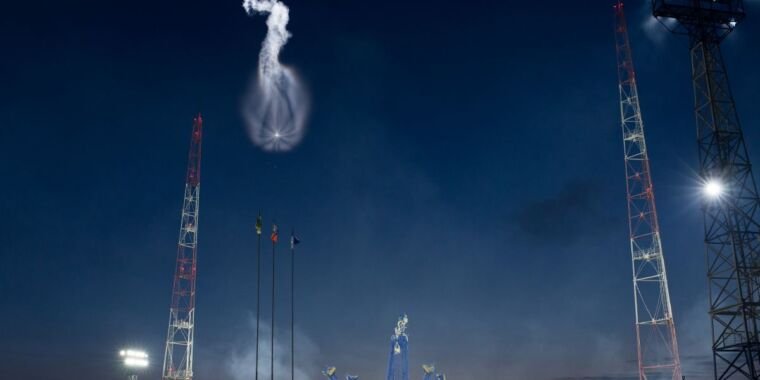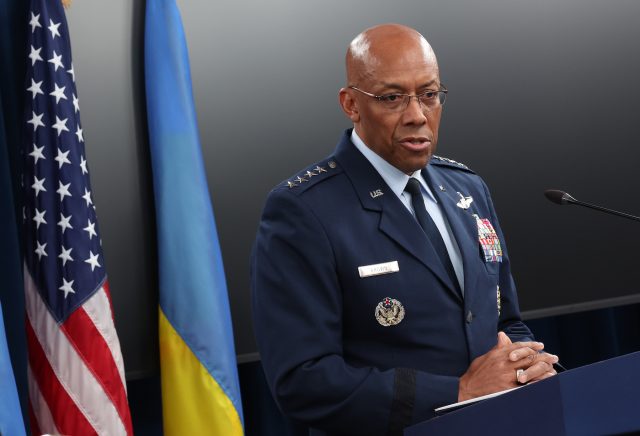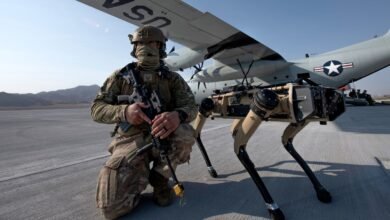US officials: A Russian rocket launch last week likely deployed a space weapon


The launch of a classified Russian military satellite last week deployed a payload that US government officials say is likely a space weapon.
In a series of statements, US officials said the new military satellite, named Kosmos 2576, appears to be similar to two previous “inspector” spacecraft launched by Russia in 2019 and 2022.
“Just last week, on May 16, Russia launched a satellite into low-Earth orbit that the United States assesses is likely a counter-space weapon presumably capable of attacking other satellites in low-Earth orbit,” said Robert Wood, the deputy US ambassador to the United Nations. “Russia deployed this new counter-space weapon into the same orbit as a US government satellite.”
Kosmos 2576 is flying in the same orbital plane as a National Reconnaissance Office (NRO) spy satellite, meaning it can regularly approach the top-secret US reconnaissance platform. The launch of Kosmos 2576 from Russia’s Plesetsk Cosmodrome on a Soyuz rocket was precisely timed to happen when the Earth’s rotation brought the launch site underneath the orbital path of the NRO spy satellite, officially designated USA 314.
The Soyuz rocket’s Fregat upper stage released Kosmos 2576 into an orbit roughly 275 miles (445 km) above Earth at an inclination of 97.25 degrees to the equator.
Conventional but concerning
So far, Kosmos 2576 is nowhere near USA 314, a bus-size spacecraft believed to carry a powerful Earth-facing telescope to capture high-resolution images for use by US intelligence agencies. This type of spacecraft is publicly known as a KH-11, or Keyhole-class, satellite, but its design and capabilities are top-secret.
It’s no surprise that the Russian military wants to get a close look in hopes of learning more about the US government’s most closely held secrets about what it does in orbit. Russian satellites have also flown near Western communications satellites in geostationary orbit, likely in an attempt to eavesdrop on radio transmissions.
Russia’s deputy foreign minister, Sergei Ryabkov, dismissed the US government’s assessment about the purpose of Kosmos 2576 as “fake news.” However, in the last few years, Russia has steered satellites into orbits intersecting with the paths of US spy platforms, and demonstrated it can take out an enemy satellite using a range of methods.
The current orbit of Kosmos 2576 will only occasionally bring it within a few hundred kilometers of the USA 314, according to Jonathan McDowell, an astrophysicist and expert tracker of spaceflight events. However, analysts expect additional maneuvers to raise the altitude Kosmos 2576 and put it into position for closer passes. This is what happened with a pair of Russian satellites launched in 2019 and 2022.
These two previous Russian satellites—Kosmos 2542 and Kosmos 2558— continually flew within a few dozen kilometers of two other NRO satellites—USA 245 and USA 326—in low-Earth orbit. In a post on the social media platform X, McDowell wrote that the Russian military craft “shadowed US satellites at a large distance but have not interfered with them.”
Because of this, McDowell wrote that he is “highly skeptical” that Kosmos 2576 is an anti-satellite weapon.
But one of these Russian satellites, Kosmos 2542, released a smaller sub-satellite, designated Kosmos 2543, which made its own passes near the USA 245 spacecraft, a KH-11 imaging satellite similar to USA 314. At one point, satellite trackers noticed USA 245 made a slight change to orbit. Its Russian pursuer later made a similar orbit adjustment to keep up.
In 2020, Kosmos 2543 backed off from USA 245. Once well away from the NRO satellite, Kosmos 2543 ejected a mysterious projectile into space at a speed fast enough to damage any target in its sights.
At the time, US Space Command called the event a “non-destructive test of a space-based anti-satellite weapon.” The projectile fired from Kosmos 2543 at a relative velocity of some 400 mph (700 km per hour), according to McDowell’s analysis of publicly available satellite tracking data.

The US military has identified China as its most significant strategic adversary in the coming decades. Most aspects of Russia’s space program are in decline, but it still boasts formidable anti-satellite capabilities. Russia intentionally destroyed one of its retired satellites in orbit with a ground-based missile in 2021. The Russian military has also deployed several Peresvet laser units capable of disabling a satellite in orbit. A Russian cyberattack at the start of the invasion of Ukraine in 2022 knocked a commercial satellite communications network offline.
Most recently, US government officials have claimed Russia is developing a nuclear anti-satellite weapon. Russian officials also denied this. But Russia vetoed a UN Security Council resolution last month reiterating language from the 1967 Outer Space Treaty banning weapons of mass destruction in orbit.
The US military has its own fleet of inspector satellites in orbit to track what other nations are doing in space. The Space Force’s development of any offensive military capability in space is classified.
“The space domain is much more challenging today than it was a number a number of years ago,” said Air Force Gen. Charles “CQ” Brown, chairman of the joint chiefs of staff, in an event Wednesday hosted by the Atlantic Council. “We looked at it as a very benign environment, where you didn’t have to worry about conflicts in space. As a matter of fact, naming space as a warfighting domain was kind of forbidden, but that’s changed, and it’s been changed based what our adversaries are doing in space.”
“We don’t want to have our satellites … be challenged,” Brown said. “So we want to make sure that we have the capabilities to defend ourselves, no matter what domain we’re in, whether it’s in the space domain, air, land, or maritime. That’s where our focus is as a military, in making sure we’re investing to provide the capabilities and expertise to do that.”
Source link




